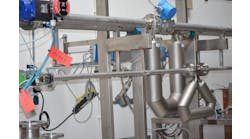The last gasoline blender upgrade was a decade or more in the past, and once again claimed millions in benefits thanks to controlling the blend so precisely that giveaway was next to nothing. Giveaway, simply put, is shipping a fuel that exceeds the specifications. By blending gasoline precisely on spec, a refinery can minimize the proportion of valued and less abundant (e.g., high octane) components, and maximize the amount of cheap components (butane, for example), which are extremely profitable to sell as gasoline. Literally millions are claimed for shaving the specification a tenth one way or the other.
It’s not a very esoteric concept. According to my neighbors, our farmers (maybe) have been known to spray down a wagon of grain that exceeded the elevator’s water specification – so effectively selling water as grain. After all, why “giveaway” grain that happened to come off the field with a lower net water content than the specification? Nonetheless, many of us who ascribe a price or a premium for quality might be dismayed that so much effort and attention is paid to delivering the very least the specification allows. But blending a fuel or synthesizing a commodity chemical differs from, say, manufacturing a car. There are few secrets and the products are virtually interchangeable. In a commodity business, the enterprise wins through volume, reliability and efficiency.
Many of the largest fuel producers blend directly to a pipeline, which, in turn, ends up in terminals where the petrol is combined with ethanol and other additives before shipping to retail outlets. Keeping this substantial stream of precisely blended fuel on specification requires the same of the instruments providing flow control and online analysis. While an off-spec tank at a terminal can sometimes be “doctored” to correct an octane or vapor pressure deficiency, it’s still a substantial disruption to the quickly consumed inventory.
For decades, the turbine flowmeter has been the staple of gasoline and similar blending operations. It’s a positive-displacement, volumetric meter that relies on a spinning turbine immersed in the flowing stream. The turbine meter is innately digital—the raw signal is the frequency generated as a transducer (e.g., magnetic pickup) effectively counts the blades spinning by. The frequency is directly proportional to volumetric flow. But such simplicity is complicated by its mechanical design – bearings immersed in a flowing stream will eventually wear out and fail, so meters are routinely pulled or exchanged for freshly calibrated sensors. Straight runs are required to ensure a symmetrical flow and limit turbulence, and the streams must be filtered to prevent entrained particulates and other flotsam from corrupting the precision-engineered vanes and bearings. Each stream must be reliably single-phase (all gas or all liquid) and the flowing temperature (and pressure for gas applications) must be monitored to account for the density of the stream.
While sometimes it seems like refinery cultures cling to past practices, the more modern Coriolis flowmeter can help ensure a blender upgrade’s million-dollar return-on-investment is realized. Particularly when integrated over fieldbus, Ethernet, or equivalent high-speed and time-sensitive digital network, Coriolis meters equal or exceed the turbine meter for accuracy and turndown. Innately digital (measuring frequency and phase shift resulting from the Coriolis effect, the Coriolis meter requires no straight run, and diagnostics can immediately detect two-phase flow or blockage. The Coriolis phase shift is directly proportional to mass flow, and the characteristic frequency of the meter tubes can repeatably measure density to three or even four decimal places. For the optimum accuracy and turndown, a line-size reduction is not uncommon, and dual-tube meters will further reduce the effective line size as the fluid passes through the meter body—hence the pressure loss can be higher and might be a limiting factor. Different face-to-face dimensions will most likely require some piping modifications; improper pipe alignment causing twisting or bending torque on the flow tube should also be avoided.
In recent years, Coriolis specialist Micro Motion has introduced a feature they call Smart Meter Verification. Especially useful in a blending application, this permits the end user to validate a sensor in the line without having to remove it for recertification.
Especially in large line sizes, Coriolis meters are far from the least expensive solution. But their capabilities and features in a digitally-integrated blender have the potential to justify the premium.






